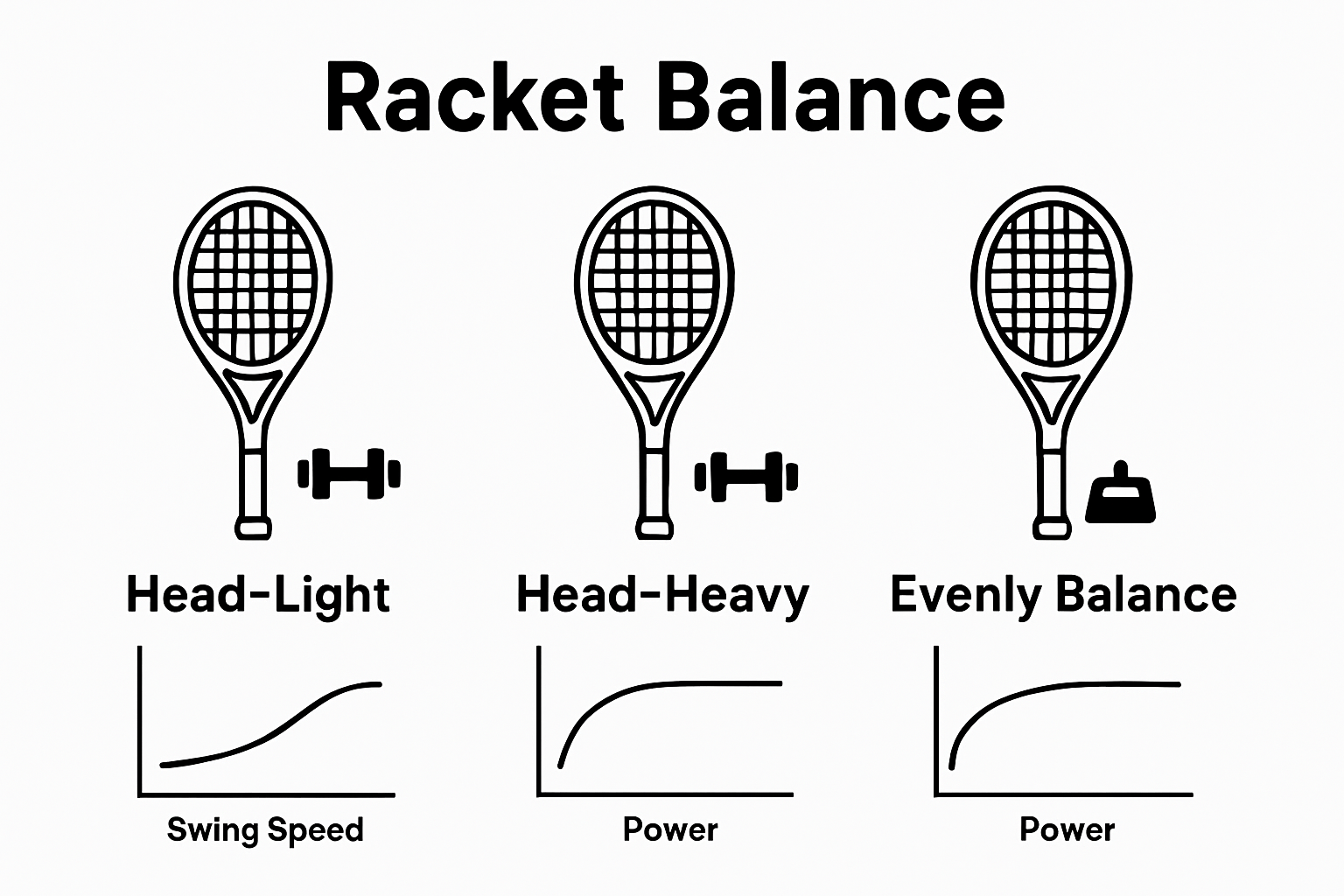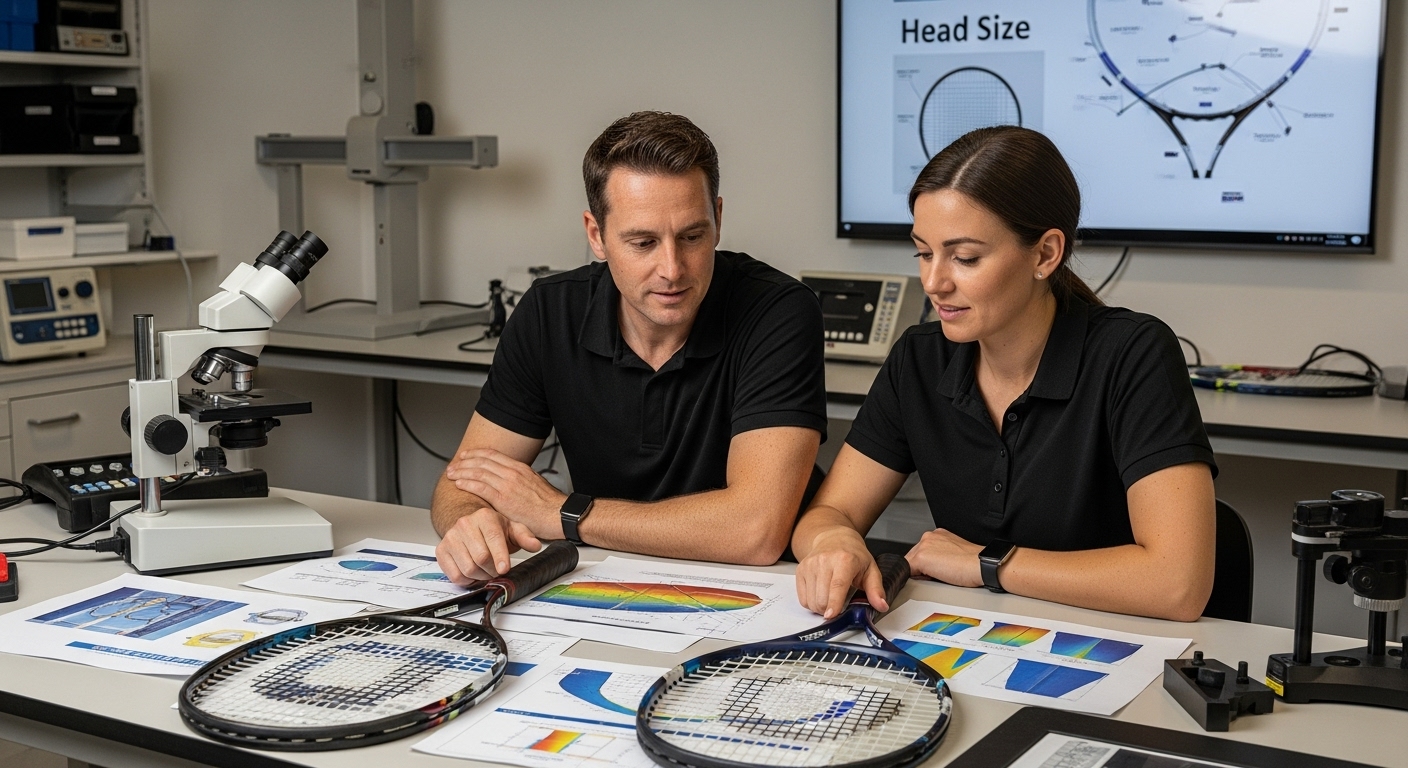Tennis rackets might look simple, yet every small design detail can change how you play. Think about this. Some pro rackets use carbon nanotubes at the molecular level for strength lighter than aluminum and five times tougher than steel. Most players believe power comes just from your swing and practice. The real secret? Racket engineering does a lot of the heavy lifting, often shaping the outcome of every single shot.
Table of Contents
- What Are The Essential Features Of Tennis Rackets?
- Why Do Material Types Matter In Racket Performance?
- How Racket Weight Influences Swing And Power
-
Understanding Racket Balance And Its Impact On Control
- [Balance Point Mechanics
 ](#balance-point-mechanics)
](#balance-point-mechanics)
- Biomechanical Interaction Principles
- Control And Performance Optimization
- The Role Of Head Size In Molding Your Playing Style
Quick Summary
| Takeaway | Explanation |
|---|---|
| Material choice affects performance. | Racket composition determines strength, flexibility, and resonance during ball contact, impacting player abilities. |
| Weight influences control and power. | Racket weight defines swing dynamics, with lighter racks aiding maneuverability and heavier ones enhancing power. |
| Balance shapes swing characteristics. | Racket balance impacts player technique, affecting speed, power, and shot precision through distribution of mass. |
| String pattern impacts ball control. | The configuration of strings affects spin and power; players should select patterns to suit their play style. |
| Head size expands sweet spot. | Larger racket heads create a forgiving impact zone, improving shot accuracy and reducing vibration from off-center hits. |
What Are the Essential Features of Tennis Rackets?
Understanding top tennis racket features requires examining multiple critical design elements that directly impact player performance. Professional and elite tennis players recognize that a racket is far more than a simple piece of sporting equipment - it is a precision instrument crafted to maximize power, control, and technique.
Racket Material and Construction
The foundational aspect of top tennis racket features begins with material selection. Modern rackets typically utilize advanced composite materials that balance strength, flexibility, and weight. According to scientific research from USC, the material composition significantly influences how energy transfers during ball contact.
Key material considerations include:
- Carbon fiber composites for lightweight durability
- Graphite blends providing superior vibration dampening
- Aluminum alloys offering consistent structural integrity
- Hybrid material constructions maximizing performance characteristics
Professional players understand that material choice directly impacts racket responsiveness, weight distribution, and overall playing dynamics.
Below is a comparison table summarizing the major tennis racket material types and their key performance characteristics for elite players.
| Material Type | Strength & Durability | Vibration Dampening | Weight | Performance Notes |
|---|---|---|---|---|
| Carbon Fiber Composite | Excellent | Good | Very Light | Top choice for strength and light feel |
| Graphite Blend | Very Good | Excellent | Light | Superior shock absorption |
| Aluminum Alloy | Good | Moderate | Moderate | Consistent structure, slightly heavier |
| Hybrid Composite | Excellent | Very Good | Light | Maximizes multiple characteristics |
| Nano-Engineered Composite | Exceptional | Excellent | Ultra Light | Maximum power and responsiveness |
Weight and Balance Dynamics
Weight and balance represent another crucial dimension of top tennis racket features. The distribution of mass determines how players generate power, control ball trajectory, and manage swing mechanics. Rackets are typically classified into three primary weight categories:
- Lightweight rackets (under 10 ounces) for enhanced maneuverability
- Midweight rackets (10-11 ounces) providing balanced performance
- Heavyweight rackets (over 11 ounces) delivering maximum power potential
The precise balance point between handle and head influences swing characteristics. Head-heavy rackets generate more power, while head-light designs offer superior control and faster swing speeds.
String Pattern and Tension Considerations
The final critical feature involves string configuration, which dramatically affects ball spin, power, and overall playing experience. Professional players meticulously select string patterns based on their individual playing style. Mathematical analysis from advanced physics research reveals how string tension and spacing mathematically influence ball trajectory and spin generation.
Open string patterns with wider spacing create more potential for spin and power, while dense patterns provide enhanced ball control. String tension ranges typically between 50-65 pounds, with each increment producing nuanced performance variations that serious players carefully evaluate.
Ultimately, selecting the right tennis racket involves understanding these interconnected features and matching them to individual playing techniques and preferences.
Why Do Material Types Matter in Racket Performance?
The selection of materials in tennis racket manufacturing represents a complex engineering challenge that directly influences player performance, power generation, and technical precision. Understanding the nuanced relationship between material composition and racket functionality provides insights into how advanced engineering transforms sporting equipment.
Mechanical Properties and Energy Transfer
Material selection fundamentally determines a racket’s mechanical behavior during ball contact. According to groundbreaking research in Sports Biomechanics, different material compositions significantly impact critical performance parameters such as energy transfer, vibration absorption, and structural responsiveness.
Key mechanical considerations include:
- Stiffness coefficient determining power transmission
- Impact resistance preventing structural deformation
- Damping characteristics reducing unwanted vibrations
- Structural integrity maintaining consistent performance
Advanced composite materials like carbon fiber and graphite blends enable manufacturers to engineer rackets with precisely calibrated mechanical properties that enhance player capabilities.
Molecular Structural Advantages
At the microscopic level, material selection influences racket performance through molecular structural advantages. Sophisticated composite materials integrate multiple molecular components to create superior structural characteristics. Nano-engineered composites represent the pinnacle of racket material technology, allowing unprecedented control over mechanical properties.
Critical molecular design elements include:
- Carbon nanotube reinforcement
- Polymer matrix integration
- Molecular bonding techniques
- Composite layering strategies
These advanced molecular engineering approaches enable racket manufacturers to create lightweight yet incredibly strong sporting instruments that maximize player potential.
Performance Optimization Strategies
Professional tennis equipment designers leverage advanced material science to develop rackets that offer competitive advantages. Systematic research in material engineering demonstrates how precise material selection can dramatically enhance racket performance across multiple dimensions.
Optimization strategies focus on balancing multiple performance characteristics:
- Minimizing weight while maintaining structural strength
- Maximizing energy return during ball impact
- Reducing unwanted vibration and shock transmission
- Creating consistent performance across varied playing conditions
Ultimately, material types are not merely technical specifications but sophisticated engineering solutions that transform tennis rackets from simple sporting equipment into precision performance instruments.
How Racket Weight Influences Swing and Power
Racket weight represents a sophisticated engineering parameter that profoundly impacts a tennis player’s performance, transforming seemingly minor mass variations into significant competitive advantages. Understanding how weight influences swing mechanics and power generation requires delving into complex biomechanical interactions between player and equipment.
Mass Distribution and Swing Dynamics
The distribution of mass within a tennis racket fundamentally determines its swing characteristics and energy transfer potential. According to research published in the British Journal of Sports Medicine, weight placement critically affects a player’s ability to generate power and control ball trajectory.
Key swing dynamic considerations include:
- Handle weight influencing initial acceleration
- Head weight determining impact momentum
- Balance point mediating rotational inertia
- Mass distribution affecting swing speed
Swing weight emerges as a more nuanced concept than simple mass, representing how a racket feels during motion and its resistance to angular acceleration.
Muscle Engagement and Biomechanical Response
Racket weight directly interacts with a player’s muscular system, creating complex biomechanical adaptations. Different weight configurations trigger specific muscle activation patterns that modify swing mechanics and energy transmission.
Biomechanical interaction points include:
- Muscle coordination adjustments
- Activation level modifications
- Energy expenditure variations
- Neuromuscular recruitment strategies
Professional players intuitively understand these subtle interactions, selecting rackets that complement their physiological strengths and playing style.
Performance Optimization Strategies
Elite tennis equipment designers recognize that racket weight optimization involves balancing multiple performance parameters. The goal transcends simply making rackets lighter or heavier, focusing instead on creating precise weight configurations that enhance player capabilities.
Performance optimization strategies emphasize:
- Minimizing swing weight without reducing impact momentum
- Balancing mass across different racket zones
- Creating lightweight designs with maximum energy transfer
- Developing rackets that reduce muscular fatigue
Ultimately, racket weight represents a sophisticated engineering solution that bridges advanced materials science with human biomechanical potential, transforming equipment from a passive tool into an active performance enhancement mechanism.
Understanding Racket Balance and Its Impact on Control
Racket balance represents a sophisticated engineering parameter that transcends simple weight measurements, profoundly influencing a player’s technical capabilities and shot precision. By strategically distributing mass across the racket’s structure, manufacturers create instruments that dramatically modify player performance and shot control.
The following table outlines how different racket balance types impact swing characteristics and control, helping players select the optimal configuration for their style.
| Balance Type | Balance Point Location | Key Swing Effect | Primary Benefit | Ideal For |
|---|---|---|---|---|
| Head-Light | Closer to handle | Faster swing speeds | Enhanced control | Net players, volleying |
| Head-Heavy | Closer to racket head | Slower swing, more momentum | Increased power | Baseline power hitters |
| Evenly Balanced | Centered | Balanced swing feel | Versatile performance | All-court players |
Balance Point Mechanics
The balance point determines how a racket responds during swing and impact, creating nuanced performance characteristics. According to research in the Journal of Sports Sciences, different balance configurations produce measurably distinct performance outcomes.
Key balance point configurations include:
- Head-light balance promoting faster swing speeds
- Head-heavy balance generating increased power
- Evenly balanced rackets offering versatile performance
- Dynamic balance points adapting to specific playing styles
Balance point represents the precise location where the racket maintains equilibrium when suspended horizontally, serving as a critical engineering metric for performance optimization.
Biomechanical Interaction Principles
Racket balance directly influences a player’s biomechanical responses, creating complex muscular adaptations during different stroke techniques. Professional players intuitively understand how balance affects their ability to generate spin, control trajectory, and manage energy transfer.
Biomechanical interaction elements include:
- Muscle activation pattern modifications
- Neuromuscular coordination adjustments
- Energy transmission efficiency
- Swing arc and acceleration characteristics
These subtle interactions transform racket balance from a technical specification into a sophisticated performance enhancement mechanism.
Control and Performance Optimization
Elite tennis equipment designers recognize that balance represents a critical parameter in creating rackets that extend human athletic potential. The objective transcends merely distributing mass, focusing instead on engineering precise balance configurations that amplify player capabilities.
Performance optimization strategies emphasize:
- Minimizing muscular fatigue through optimal weight distribution
- Enhancing shot consistency across different stroke types
- Creating intuitive racket responses matching player techniques
- Developing balance configurations that reduce injury risks
Ultimately, racket balance emerges as a complex engineering solution that bridges advanced materials science with human biomechanical potential, transforming equipment from a passive tool into an active performance enhancement mechanism.
The Role of Head Size in Molding Your Playing Style
Racket head size represents a critical design parameter that fundamentally transforms a player’s technical approach, serving as a sophisticated engineering mechanism that directly influences stroke mechanics, power generation, and overall playing strategy. Understanding how head size impacts performance requires exploring its nuanced interactions with player technique and biomechanical potential.
Sweet Spot and Impact Dynamics
The head size determines the racket’s sweet spot, a crucial performance parameter that influences shot precision and power transmission. According to research from the United States Tennis Association, larger head sizes create more forgiving impact zones and enhanced energy transfer characteristics.
Key sweet spot considerations include:
- Larger heads providing expanded error-tolerance zones
- Increased surface area improving ball contact consistency
- Enhanced energy transmission across impact regions
- Reduced vibration during off-center hits
Sweet spot size emerges as a critical performance metric, transforming seemingly minor design variations into significant competitive advantages.
Biomechanical Adaptation Strategies
Racket head size directly influences a player’s biomechanical responses, creating complex muscular and technical adaptations. Professional players intuitively understand how head size modifications can alter swing mechanics, spin generation, and shot trajectory control.
Biomechanical interaction elements include:
- Swing arc modification strategies
- Muscular engagement pattern adjustments
- Energy transfer efficiency variations
- Stroke technique optimization techniques
These intricate interactions demonstrate how head size transcends a simple dimensional specification, becoming a sophisticated performance enhancement mechanism.

Performance Configuration and Style Optimization
Elite tennis equipment designers recognize head size as a critical parameter in creating rackets that extend human athletic potential. The objective extends beyond dimensional specifications, focusing on engineering precise configurations that amplify individual player capabilities.
Performance optimization strategies emphasize:
- Matching head size to specific playing techniques
- Creating intuitive racket responses
- Developing configurations supporting individual strengths
- Minimizing technical limitations through intelligent design
Ultimately, racket head size represents an advanced engineering solution that bridges materials science with human biomechanical potential, transforming equipment from a passive tool into an active performance enhancement mechanism.
Elevate Your Game with French-Crafted Tennis Equipment
After reading about the critical impact of racket features like weight, balance, and string tension, you understand that small details make all the difference for elite players. Every technical edge can translate into greater control, more power, and the confidence to play at your very best. Yet finding an instrument that truly matches your high-performance needs and reflects your commitment to precision often feels impossible among mass-produced options.

Discover a collection crafted for players who demand excellence. At SABRHERO.fr, you can shop exclusive French-made tennis rackets and accessories built to exacting standards. Experience the perfect balance of cutting-edge engineering and timeless luxury. Explore our premium selections today and see how the right design details will set you apart on the court. Visit SABRHERO.fr now. The next big step in your tennis journey starts with a single click.
Frequently Asked Questions
What materials are commonly used in elite tennis rackets?
Modern elite tennis rackets typically utilize advanced composite materials such as carbon fiber, graphite blends, and aluminum alloys. These materials are chosen for their lightweight durability and ability to enhance performance characteristics like vibration dampening and energy transfer.
How does racket weight affect my playing style?
Racket weight influences swing dynamics and power generation. Lightweight rackets (under 10 ounces) enhance maneuverability, while heavyweight rackets (over 11 ounces) provide maximum power. The right weight for you depends on your playing style and preferences.
What is the significance of racket balance in performance?
Racket balance affects how the racket feels during swings and impacts. Head-light balances promote faster swing speeds and control, while head-heavy balances generate more power. Finding the right balance for your playing style can significantly enhance shot precision and control.
How does head size influence a player’s performance?
Racket head size determines the size of the sweet spot, influencing shot precision and power. Larger head sizes offer more forgiving impact zones, improving consistency and energy transfer on off-center hits, while smaller heads provide greater control for advanced players.
